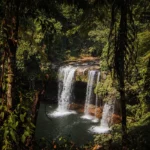Laos wasn’t at the top of our list. In fact, we didn’t expect much from it.
We didn’t come for a world-famous landmark or some viral photo spot. We came because we kept hearing whispers from other travelers, from locals in neighboring countries, that Laos was different. Slower. Quieter. Realer.
And they were right.
It’s the kind of place where motorbikes outnumber cars, where rivers double as highways, and where time feels like it stretches just a little bit longer. You won’t find giant malls or fast Wi-Fi everywhere, but you will find surreal waterfalls, villages that feel untouched, and views that hit you out of nowhere.
This isn’t a country that tries to impress you. It just is. Exactly as their slogan says: simply beautiful – in every sense of the word.
If you’re curious (really curious) about Laos, this guide is for you.
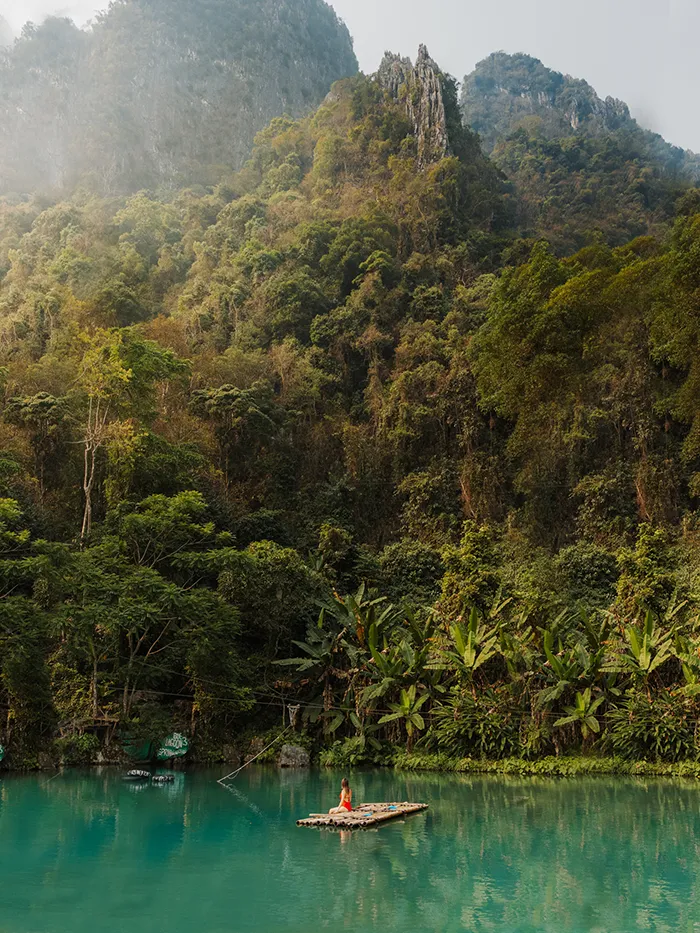
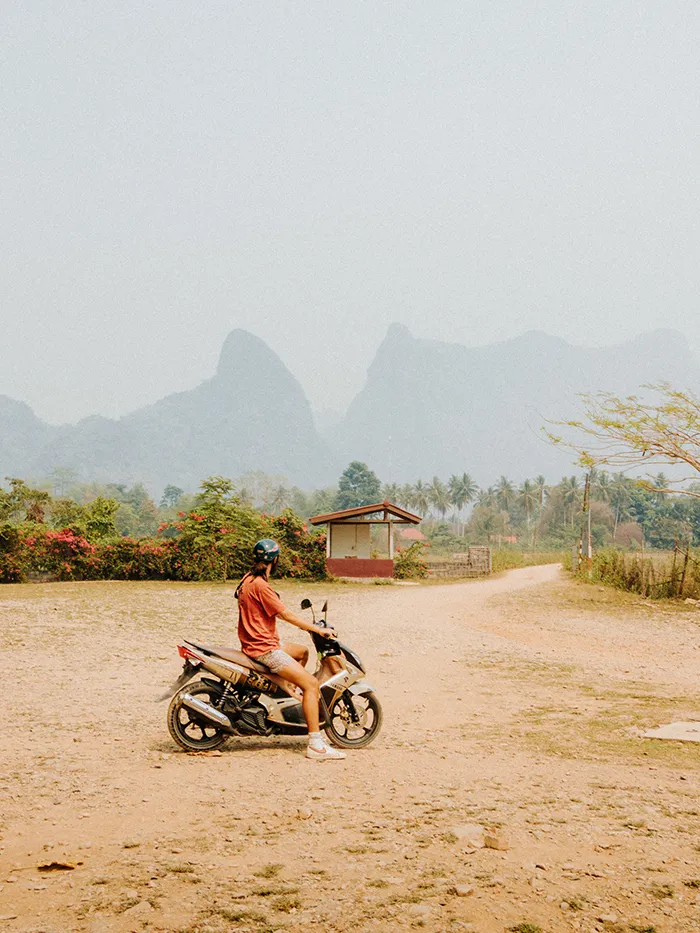
Laos Map
Laos might be landlocked, but what it lacks in coastline it makes up for in raw beauty with epic mountains, waterfalls, and riverside towns. Here’s a map to help you get your bearings across the main regions:
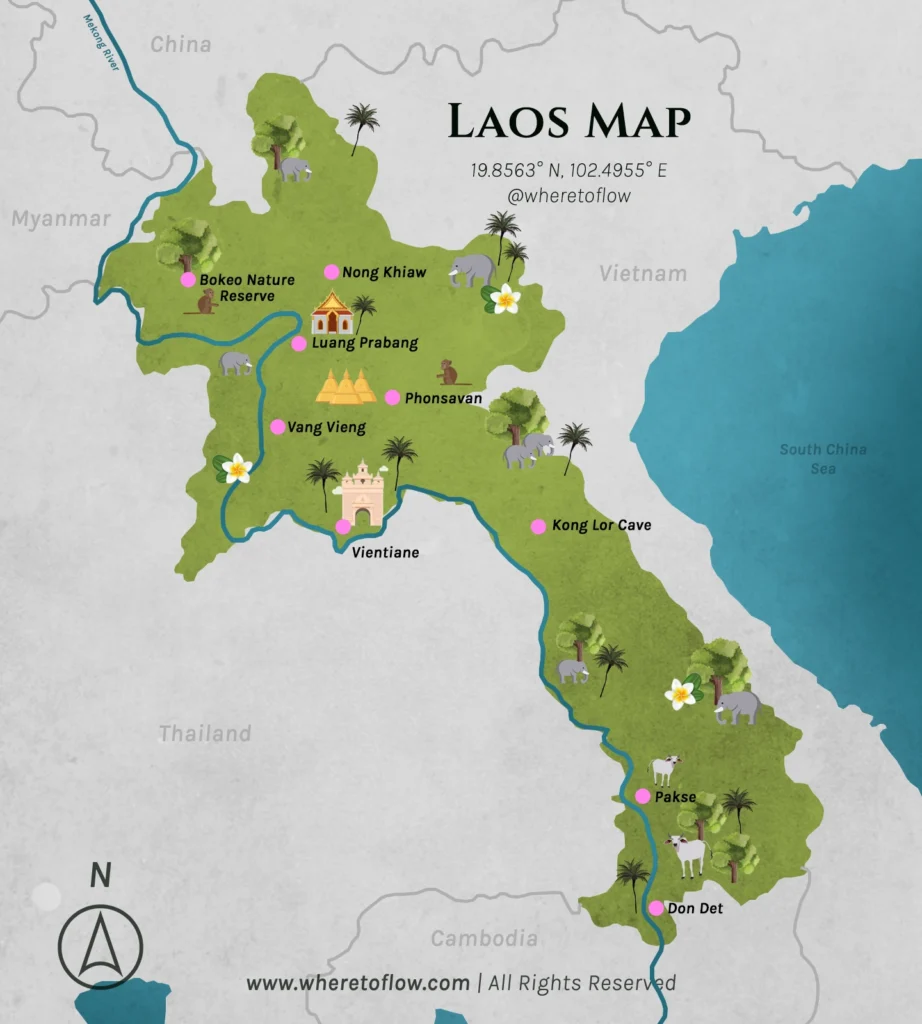
It’s about the size of the United Kingdom, but traveling the country takes time, especially with its winding mountain roads and limited infrastructure. Still, that’s all part of the charm.
Fun fact: Laos is one of the most heavily bombed countries in the world per capita, a tragic legacy from the Vietnam War. But today, it’s also one of the most peaceful countries in the world.
Must-Visit Places in Laos
1. Vang Vieng
Vang Vieng is one of those places that just has a little bit of everything. Stunning views? Check. Thrilling adventures? Definitely. Unique spots that feel like you’ve stumbled onto something special? You bet. No wonder it’s called the adventure capital of Laos.
It was once a chaotic party town, and although you can still find nightlife (if that’s your thing), these days, it’s more about nature and slower mornings than bar crawls.
Here, you can kayak or tube down the Nam Song River, take in the karst mountain views from a hot air balloon, or hike up to Nam Xay Viewpoint and sit on a motorbike at the top of a mountain, holding a Laotian flag as the sun goes down. And when it gets hot, just jump into one of the amazing Blue Lagoons.
Also read: Vang Vieng: BEST Things to Do


2. Pakse
Established by the French in 1905 (they did leave behind more than just baguettes), Pakse has evolved into the second-largest city in the country, although it’s still laid-back enough to feel like a secret.
It’s the perfect starting point for the Bolaven Plateau motorbike loop (one of the best adventures in southern Laos). And while in town, you can explore Wat Phou (a UNESCO-listed Khmer temple older than Angkor Wat) or simply relax before heading into the waterfalls and coffee plantations of the plateau.
Also read: What to Do in Pakse, Laos: Top 9 Activities You Can’t Miss


3. Phu Hin Bun National Park & the Kong Lor Cave
This one’s for the adventurers. Phu Hin Bun National Park a dense jungle home to one of Southeast Asia’s most spectacular caves: Kong Lor. Here, you’ll take a boat ride straight through the heart of a 7-kilometer cave, in complete darkness except for your flashlight.
The surrounding villages are also super peaceful, and the whole area feels far away from everything else.
Tip: We haven’t been, but we recommend reading these two guides to plan your trip: Full Guide to Kong Lor Cave by Coordinotes, and Kong Lor Cave on a budget by Land of Size.
4. Luang Prabang
Tucked between the Mekong and Nam Khan rivers, Luang Prabang is all about slow mornings, golden sunsets, and the kind of calm you didn’t know you needed. Once the royal capital of Laos, today it’s a UNESCO World Heritage town that blends French-colonial charm with deep spiritual roots and local life.
It’s also where you’ll find monks collecting alms at sunrise, stunning waterfalls like Kuang Si, and vibrant night markets full of street food and handicrafts.
Also read: What to Do in Luang Prabang: 9 Must-Have Experiences


5. Nong Khiaw Village
Nong Khiaw Village is tucked between limestone cliffs and set along the peaceful Nam Ou River. Getting here already feels like an adventure: winding roads, mountain passes, and endless rice paddies. Once you arrive, everything slows down.
Climb up to the famous viewpoint for a 360° panorama that’s worth every drop of sweat, hop on a boat to the even more remote Muang Ngoi, or just grab a hammock and let the river do the entertaining.
6. Don Det (4000 Islands)
This tiny island in the Mekong River is your perfect getaway if you’re looking to live your best slow life. If you’ve ever dreamed of a place where “to-do lists” are replaced by “do-nothing lists”, then Don Det is calling your name!
Days here are spent swinging in a hammock, biking through tiny villages, spotting rare Irrawaddy dolphins, or watching the sunset paint the Mekong gold. It’s also one of the best places in Laos to truly unplug (though you’ll still find Wi-Fi if you need it).
Also read: Don Det: Must-Do Activities, Top Stays, and How to Get There
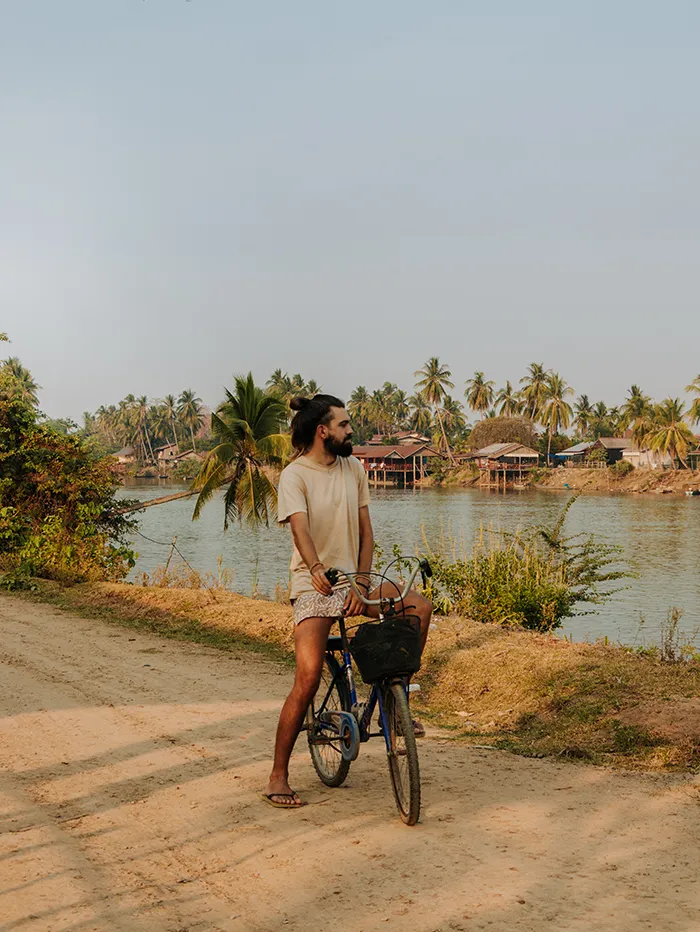

7. Phonsavan
Phonsavan doesn’t attract many tourists at all, but it should: especially if you’re into history! This is the gateway to the Plain of Jars, an archaeological site scattered with thousands of stone jars whose exact origin is still unknown.
The area is also home to lesser-known temple ruins like Wat Phou Xieng Thong, wartime relics, and memorial caves like Tham Piu, where locals honor the victims of U.S. bombings (it’s one of the areas most impacted by unexploded ordnance from the Vietnam War).
8. Vientiane
Vientiane is not your typical capital city. It’s quiet, relaxed, and often feels more like a small town. But that doesn’t mean there isn’t anything to do. You can stroll along the Mekong at sunset, explore temples like Wat Sisaket and That Luang, sip coffee at riverside cafés, or admire the oddly charming Patuxai monument (a Lao version of the Arc de Triomphe).
9. Bokeo Nature Reserve
Home to the famous Gibbon Experience, Bokeo is the ultimate jungle experience. Imagine ziplining through the treetops, waking up in a treehouse hundreds of feet above the forest floor, and maybe even spotting black-crested gibbons in the wild. It’s not a cheap activity, but if you want to do something truly once-in-a-lifetime in Laos, this is it.
Best Time to Visit Laos
☀️ Dry Season: From November to April, Laos is sunny, dry, and ideal for travel. December and January are especially great due to cooler temperatures and blue skies.
🌧️ Wet Season: May to October sees heavy rainfall, especially in the south. That said, the landscapes are lush, and there are fewer crowds, which is perfect if you like it quieter and don’t mind the random downpour.
How long to stay in Laos?
Laos isn’t a country you rush through. If you do, you’ll miss the best parts.
◾ 1 week to 10 days: Focus on one region (e.g., Luang Prabang + Vang Vieng + Vientiane).
◾ 2 to 3 weeks: A north-to-south (or vice versa) adventure including Pakse and Don Det.
◾ 3+ weeks: Add off-the-beaten-path gems like Bokeo Nature Reserve, Phonsavan or the Phu Hin Bun National Park.
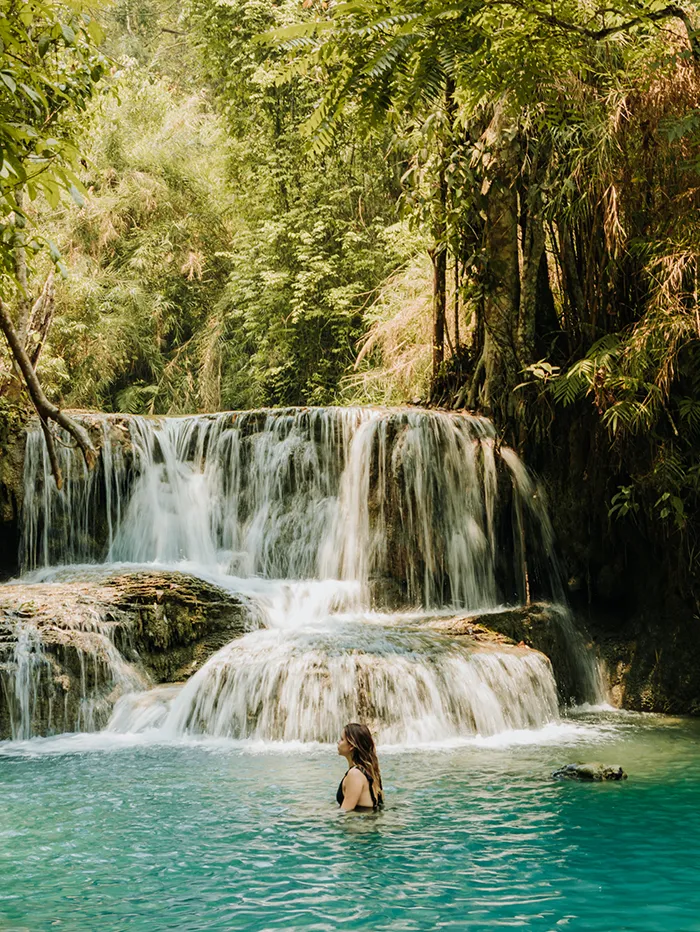
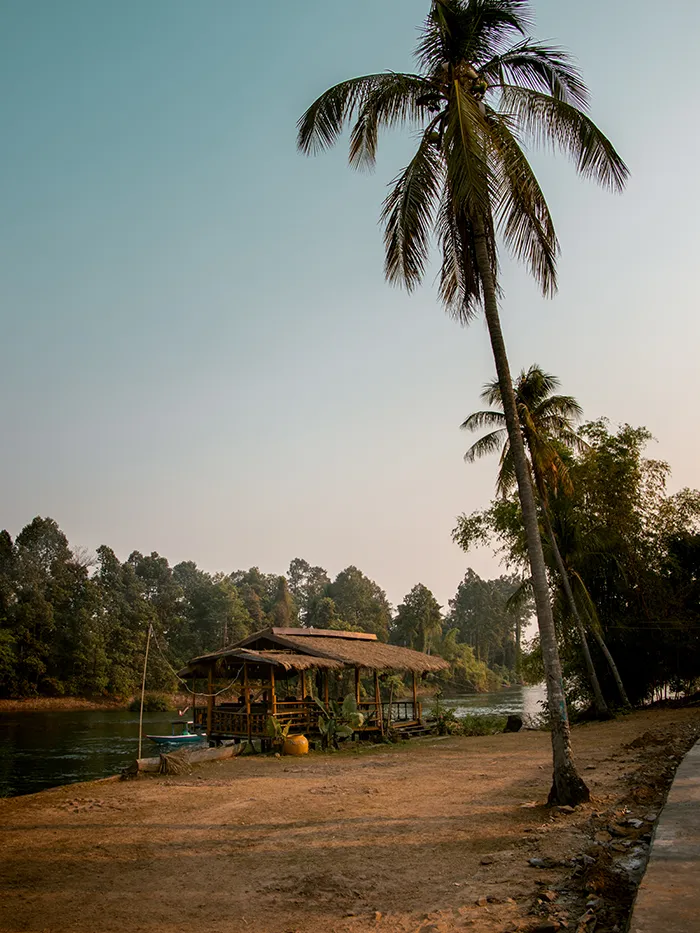
Transportation in Laos
✈️ By Air: Laos has international airports in Vientiane, Luang Prabang, and Pakse. Domestic flights are available at around €55–90 per flight. Great if you’re short on time, but not the best option for budget travelers.
🚆 By Train (Laos-China Railway): the newly built high-speed train running from Vientiane to Luang Prabang (and up to Boten near the China border) has made travel way faster and more comfortable. Trains are modern, air-conditioned, and surprisingly punctual.
A standard seat from Vientiane to Luang Prabang costs around €20–40, and the ride takes just under 3 hours, compared to 8 by bus. You can book tickets online here or at the station (but they do sell out, especially on weekends).
🚌 By Bus/Minivan: still the most common way to get around, especially for routes not covered by the train. Trips range from €9-25 depending on distance and whether you’re on a “VIP” sleeper bus or a local minivan.
🛺 By Tuk-Tuk: they are everywhere in Laos and the go-to option for short distances in cities and towns. Rides usually cost between €1-4, but prices can go up quickly if you don’t agree beforehand.
🛵 By Scooter: ideal for exploring cities and the Bolaven Plateau loop in Pakse. Rentals go for €6-9/day, and no special license is needed for scooters under 125cc.
Book your transportation in Laos here >
Pro tip: If you’re taking a minivan or night bus, bring layers as the AC is usually set to arctic. Also, always pack snacks and motion sickness pills.
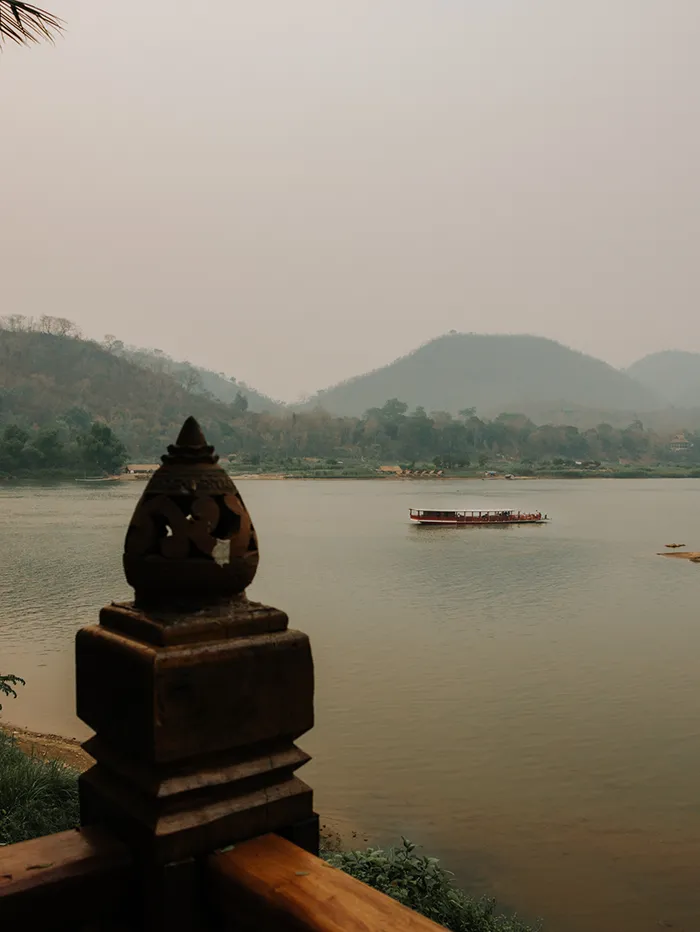
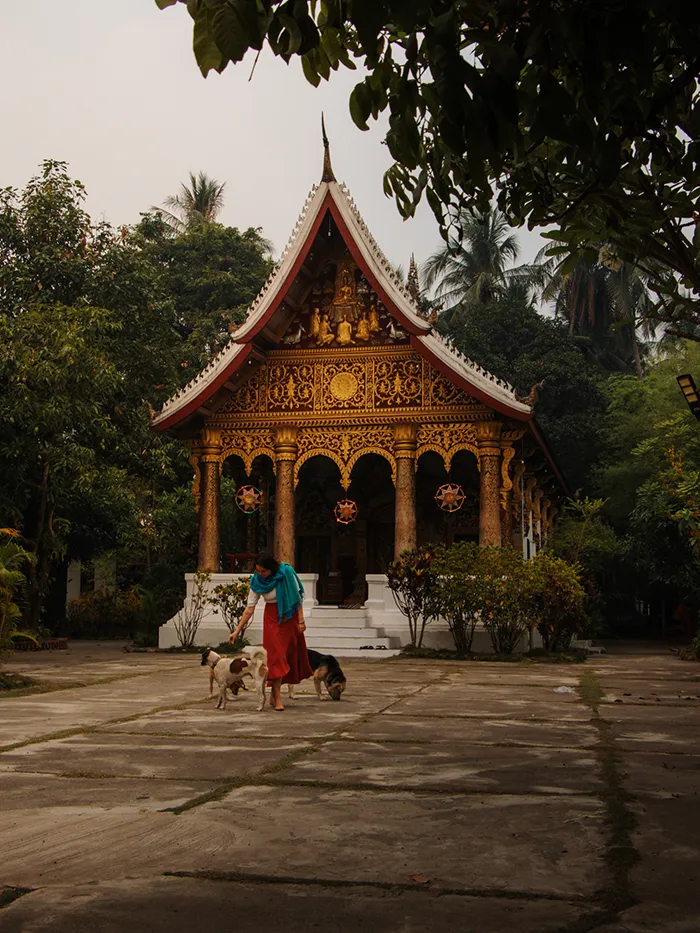
Must-Eats in Laos
Laotian food is fresh, herbaceous, and seriously underrated. Here’s what to try:
🥗 Laap (Larb): Minced meat salad with lime juice, herbs, and chili. It’s considered the national dish!
🌿 Or Lam: A spicy stew from Luang Prabang made with herbs, veggies, and buffalo meat or chicken. Earthy and filling.
🍜 Khao Piak Sen: Comfort in a bowl. A thick rice noodle soup often served for breakfast with meat, herbs, and crispy garlic.
🍚 Sticky Rice (Khao Niew): A staple with every meal. Eat it with your hands, like the locals do!
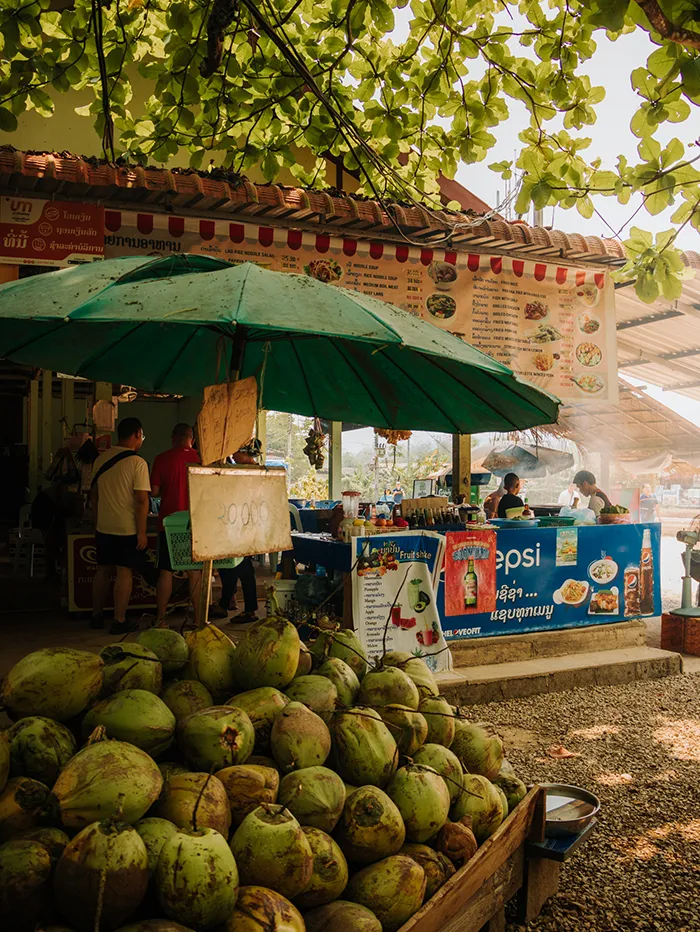
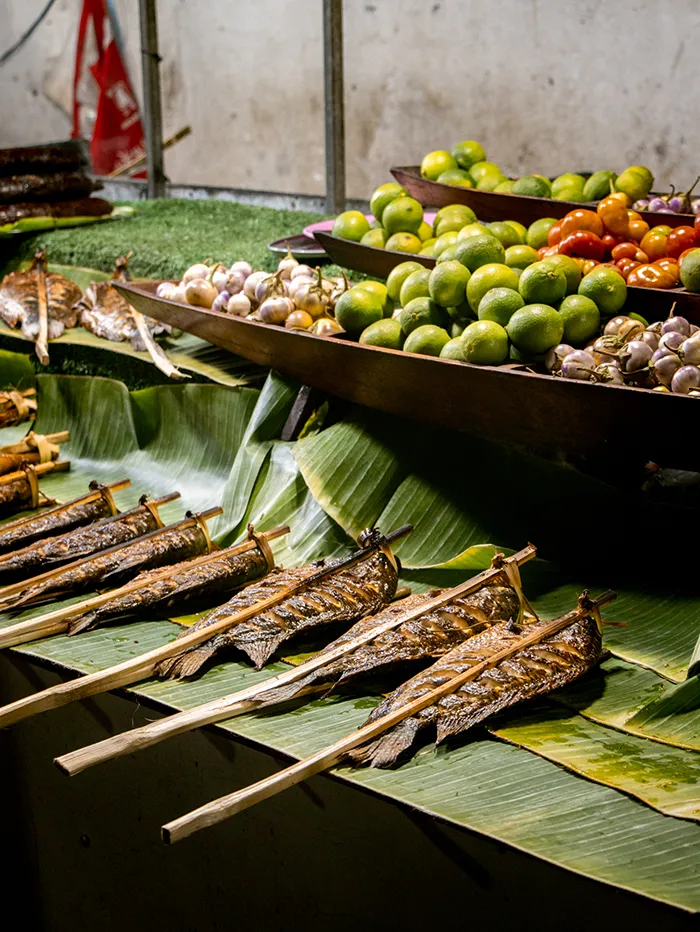
Laos on a Budget
🏠 Accommodation: Dorm beds start at €3-9, while private rooms range from €10-25. Even riverfront bungalows stay budget-friendly at around €15-30 per night.
🍜 Food: Local street food is super cheap, costing only $1-3 per meal, while restaurant dishes range from $3-7.
🚗 Transport: Buses between cities usually cost €10-30, depending on the route, and trains can cost anywhere from €20-40. Scooter rentals are usually around €6-9 per day.
🎟️ Activities: Entry to waterfalls, hikes, and temples is often just a couple of euros. Bigger activities like tubing and ziplining usually range from €10-40 depending on location.
Note: We visited Laos on a budget for a month in 2023 and managed to stay on a budget of around €23 per person per day. Prices in 2025 haven’t shifted much since we did the research for this blog post, and Laos is still one of the most affordable countries in Southeast Asia.


Essential Travel Info
1. Visa & Entry Requirements
Most nationalities can get a visa on arrival for $30-40, valid for 30 days. You’ll need a passport photo and cash in USD. You can also apply online via the eVisa system at laoevisa.gov.la. Processing usually takes 3 to 5 business days.
Note: Your passport must be valid for at least 6 months beyond your entry date. Visa is valid for 30 days, with the possibility of extension for another 30 days.
2. Health and Safety
💉 Vaccinations: No vaccines are required to enter Laos unless you’re coming from a country with a risk of Yellow Fever transmission, in which case you’ll need to show proof of vaccination.
That said, several are strongly recommended, especially if you plan to visit rural areas or stay longer than a couple of weeks. These include Hepatitis A, Typhoid, Tetanus, and Rabies. Some travelers also get Hepatitis B or Japanese Encephalitis, depending on the season and regions visited.
There’s a low malaria risk in southern Laos, particularly near the Cambodian border or deep jungle areas. For most travelers, basic mosquito precautions are enough, but if you’re going remote, chat with your doctor about antimalarials.
🚰 Food & Water Safety: Tap water in Laos is not safe to drink, so always opt for bottled, filtered, or boiled water. When eating out, stick to busy food stalls and well-reviewed restaurants to minimize the risk of food poisoning.
🎒 Scams & Safety: Laos is very safe, but petty theft can happen in touristy areas. Keep your valuables secure and be careful on the roads, especially on motorbikes. Common scams include tuk-tuk overcharging, motorbike rental damage claims, and currency confusion when paying in USD and getting change in Kip.
💣 UXO Awareness: Between 1964 and 1973, over 2 million tons of bombs were dropped on Laos (more than anywhere else in the world!). Many didn’t explode, and today, unexploded ordnance (UXO) is still scattered across parts of the countryside. Tourist areas and main trekking routes are cleared and considered safe. But if you’re heading off-the-beaten-path or hiking without a guide, never wander into unmarked fields or forested areas.
🆘 Emergency Numbers: Dial 119 for medical emergencies and 191 for police. Travel insurance is a must.
3. Extra Travel Tips
💰 Currency & ATMs: the official currency is the Lao Kip. ATMs are usually available in most towns (not Don Det and other rural areas). However, withdrawal limits are usually 1-2,000,000 LAK (~€50-100) per transaction, with fees ranging from €2-5 per withdrawal. Thai Baht and US Dollars are often accepted for larger payments.
📶 SIM Cards & Internet: the best providers are Unitel and Lao Telecom. Both have solid 4G coverage in most tourist areas, but Unitel generally gets better reviews for speed and reliability. You can pick up a SIM card at the airport, in small phone shops, or even in convenience stores for around €4-6.
Note: Wi-Fi is available in most hotels, cafés, and hostels. It works fine for basic stuff like emails or scrolling, but don’t expect lightning-fast uploads in remote villages. If you plan to work online or upload content, a SIM card from Unitel is usually the more reliable option.
🔌 Voltage & Plugs: 230V, 50Hz. Plugs are Type A, B, C, and E. Bring a universal adapter just in case.








